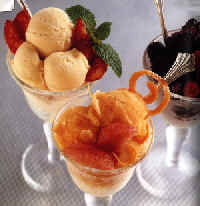
|
|
History of Ice Cream
 |
As a precursor to ice cream, frozen "slushee" type drinks have been around since Alexander the Great. Before battles, he had ice brought down from the mountains and dug into troughs to cool his wine and spirits. Marco Polo is believed to have brought similar concoctions back from China--fruit juices and milks were used to diversify these cooling elixirs. |
| The starting point for modern day ice cream appears to be in Italy during the
Renaissance. The outburst of creativity in this period flowed in all directions and
inspired chefs churned sweetened cream mixtures into Italian ices and gelato. However, ice
cream was mainly a special treat for the rich. Catherine de Medici, an Italian noble who
was married off at 14 to the Duke of Orleans brought the secret with her to France. Ice
cream was also served in the court of Louis XIV. Another sneaky French chef brought the
secret formula to England where Charles I paid him to keep it a secret. When he died, this
same chef sold the formula to a consortium of wealthy merchants. Once the secret was out,
ice cream flourished all over England and France. George Washington, Dolly Madison and Thomas Jefferson are reported to have enjoyed ice cream once it had emigrated to these shores. Dessert lovers, vendors, merchants and hucksters and a few truly visionary Americans are credited with inventing the myriad of ways we have come to enjoy eating ice cream. The ice cream sundae was designed to allow ice cream to be sold on Sundays, "The Lords day", when slurping an ice cream soda was not allowed. The sundae was quieter and the spelling changed so as not to appear to be mocking the Lords day. Hot fudge sundaes were first served at C.C. Browns in Hollywood by an unknown and long forgotten "soda jerk". This hot and cold sensation is still one of ice cream lovers favorites. Immigrants arriving at Ellis Island in the 1920’s were given food considered "typical " American. But many of them tried to spread this "frozen butter" on bread when given ice cream! Ice cream slathered in a stiff meringue and browned in the oven was popular over a century ago in Europe, but the American ego is evident by the outright plagiarism of taking this recipe for " Creme Norvigienne" and renaming it "Baked Alaska" after the coldest place on this continent. During WWII, airmen placed a mixture for ice cream in the tail gunners cockpit. The freezing air and the planes vibration made a delicious ice cream once the pilot had landed. The first wholesale ice cream business opens in Baltimore in 1851. Most ice cream at this time is hand cranked and enjoyed on the spot, whether home made or at a concession stand. Freezer sections at the market and home freezers as we know them are not yet a reality. Home refrigerators of the ice block variety begin selling in the 1920’s, with over 75,000 sold by 1925. By 1937 mechanical refrigerators are being produced at the rate of 3 million per year. Paving the way for frozen dinners followed by ice cream, Clarence Birdseye is hard at work patenting methods to freeze pre-cooked foods. The ice cream cone was first introduced at the St. Louis Exposition of 1904 when an ice cream vendor ran out of bowls; a neighboring pastry maker rolled the ice cream in crisp wafers and called them "cornucopias". Several other claim to have originated the cone, including an Italian immigrant who had obtained a patent earlier that year . In 1899, ice cream sales are at 5 million gallons, by 1909 they reach 30 million gallons and by 1919 they reach 150 million gallons. By the early 1990’s, it is a 2.2 billion dollar industry. We all know the story of the two 20-something hippies who started making ice cream in the 1970’s in Vermont--Ben & Jerry’s went on to become one of the biggest socially conscious business success stories of our time. But how many know the story of Reuben Mattus? Reuben has been peddling his families ice cream since he was 17, originally from a horse and buggy. In 1959, at the wise age of 47, he notices the poor quality of commercial ice cream. Reuben decides to make ice cream on a large scale, the same way his family has always made it, with MORE butterfat and LESS air filler than other ice cream makers. His commitment to quality is a gamble, and he goes a step further by inventing a fictitious Danish sounding name, packs the product in cartons with a map of Scandinavia and creates a new category called superpremium ice cream. The gamble pays off and Haagen Dazs becomes a multimillion dollar venture. Many of us know ice cream better from the superpremium category than any of the boxed style ice creams. And the Haagen Dazs and Ben & Jerry’s parlors charge more for a double scoop cone than our parents and grandparents would have paid for an entire box. But the taste is all we need to convince us it is money well spent, a little bit of luxury to enhance an ordinary day. |
|
Featured |